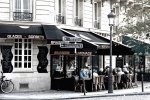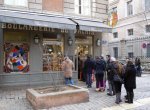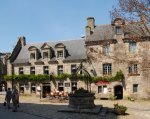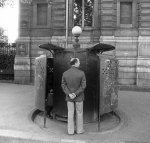Strasbourg Christmas markets
Enjoy a personal journey around the Strasbourg Christmas markets and discover the amazing way this town is taken over by the festive holidays.
A personal recollection of Strasbourg Christmas markets
The decision to have a second vin chaud was not taken lightly; we discussed it earnestly as we walked the ten metres back to the stall, trying to decide whether the wine was a Bordeaux, the recently arrived Beaujolais Nouveau or a simple plonk, and in the process convinced ourselves about the beneficial qualities of swigging large quantities of warm red wine imbued with oriental spices.
Then, clutching our steaming, aromatic brew – purely medicinal, of course – we side-stepped the milling tourists waiting to see the horloge astronomique, and perched on the cathedral steps.
All around, the bright lights of Strasbourg’s Christmas markets – the oldest in France, with a pedigree that extends back to 1570 – brought a cheery warmth to the gathering twilight, and symbolised, as does Christmas itself, the victory of light over darkness.
As I trained my camera upwards onto the soft red details of the illuminated cathedral, the passing French people, unfailingly polite, waited until I’d taken my picture – they would have had to have been riding on the top of a giraffe balanced on top of a double-decker bus to appear in any of the pictures; but it was comme il faut, a question of manners.
Close by, beneath the canopy of the Maison Kammerzell – surely the most beautiful building in the city – a five-piece band (accordion, double bass, guitar, clarinet and saxophone) faced a firing squad of camcorders, but were doing their best with, bizarrely, The Girl from Ipanema. Somehow, in the mellow half-light it seemed to work: maybe it was the wine, maybe it was simply the magic of Strasbourg Christmas markets, maybe it didn’t matter: if you’re too pragmatic about these things, you lose the essence of the moment.
Who, after all, simply wants to record these events? Isn’t it better to be part of them? To feel embraced? The memory always lingers on, as the song goes.
christkindelsmarik at the Strasbourg Christmas markets
December in Strasbourg is all about the Christmas market; there are many others in the surrounding villages of Alsace, but Strasbourg is the main centre of attention at this time of year.
In 2010, the market celebrated its 440th birthday, the expression ‘Christkindel’ – the infant Jesus – being first recorded when a Protestant priest, Johannes Flinner, successfully persuaded the city burghers that the term would be more suitable than the prevailing association with Saint Nicolas, the then king of Christmas, but who happened to be championed by Rome and the Catholics. The Christkindelsmärik that survives today began at the same time.
This is a time when everyone is allowed to be a child: adults gorge themselves on barbe à papa (candy floss), bretzels, brioche and (pommes d’amour) toffee apples made from the late-ripening crunchy red apples of Alsace, and the kids are traumatised with joy.
But there is a technique to getting the best first impression of the market. Somehow, you must plan an approach that avoids all the distractions of place Kléber with its huge Christmas tree, and the ‘Village of Sharing’ – a small group of charity-based stalls – sheltering beneath its branches, and find your way to place Gutenberg.
Sneak past the miniature steam train selling marrons chauds (hot chestnuts), and stroll up the rue des Hallebardes until you can turn into the place de la Cathédrale. Et voila! The sudden effect is stunning: the sounds, the lights, the heady aroma of spices and the towering cathedral itself all combine to make this a memorable moment – it is simply quite wonderful, and an experience not to be missed.
The Chriskindelsmärik, the Infant Jesus Market, began as a three-day event in front of the cathedral. Traditionally, it is a place where the family has gone en masse to buy the Christmas tree, the cradle and all the decorations. Later, the site moved across the square to the place du Chateau, before uprooting some years later and moving first to the place Kléber, and finally settling in place Broglie, where it has been since 1871.
Today, there is some element of the market in all these places, as well as at the place de la Gare, where the independent bakers and pastry makers gather in a large marquee brimming with gingerbread, männele (brioche cake), lekerle (spicy biscuits), bretzel (savoury biscuit), Christolle (heavy Christmas bread), and a whole range of bredele (butter biscuits), none of which is even remotely conducive to a low-calorie diet!
With an enthusiasm bordering on fanaticism, the entire city of Strasbourg is, for the whole of December, effectively given over to Christmas. Christmas trees gather around cribs, decorated with Advent crowns and candles, wooden stalls sell spices, cake moulds, decorative cloth, pottery, jewellery, trinkets, objets d’art, heart-shaped gingerbread cakes, biscuits, apples, dried fruit and enough fast food, in the form of sandwiches and pizzas, to sustain even the most weary soul.
University students dance spontaneously with the musicians, jugglers juggle, accordionists accordion – some even sing as well; there’s no agro, no angst, just good-natured fun. And lots of it. With the sort of panache only the French in party mood could effect, office façades are illuminated in different colours, as, too, are attic windows.
Santa Clause shins up countless drainpipes. Rudolph and his Merry Men career across sloping rooftops. Bears, baubles and balloons decorate every balcony, every window sill, every doorway.
You’ll meet Father Christmas round every corner; and, confidentially, I was tipped off that this is not the real Father Christmas. But this is a time for pretence and make-believe. So, don’t take it out on Father Christmas’s stand-in just because last year you didn’t get what you wanted. I asked for a BMW; I got a DVD – elves are just not very good with alphabets; that’s the way of things. Live with it.

Out at Petite France you’re away from the hub of things, but that doesn’t mean you can’t find the Christmas beer, the hip-destined calorific goodies, the gifts, the toys, the merriment and the good humour. On the tram I got chatting with a sprightly 81-year old. I offered her my seat, but she wasn’t content until I squeezed in beside her – a proper little vixen! She’d long ago married an Alsacien man, but he was killed in the Second World War; later she remarried, to a restaurateur: now we’re talking. But she could no longer take the richness of the food he prepared. Even so, it was Christmas, and she was doing the best she could. ‘Drink lots of milk’, she advised, ‘it will help. And enjoy Strasbourg.’ She was from Paris, but she would never go back. Alsace and Strasbourg were infectious. We were beginning to understand why.
Enfin, when it all gets too much, do what we did and drop into the friendly atmosphere of a nearby café, or winstub, for mulled wine, a coffee or a bottle of the specially brewed Christmas beer. It will take the chill out of the Alsacien winter air.
That, at least, is my excuse, and I’m sticking to it.
Leaves of the Maidenhair tree (Ginkgo biloba) in a city centre park
Anis
Bredele
(Aniseed-flavoured
petits-fours)
Ingredients:
600g plain flour (sieved);
500g of caster sugar;
6 eggs;
3 packets of
vanilla-flavoured sugar;
30g of aniseed grains.
Method:
Beat the eggs with the caster sugar and the vanilla-flavoured sugar for about
20 minutes, to obtain a frothy mixture that forms a ribbon off the fork.
Blend
in the aniseed grains and the sieved flour, and mix carefully.
Pipe the mixture
through a forcing bag with an 8mm mouth, onto a floured, buttered baking tray
to form small domes 2cm in diameter.
Leave overnight to dry, at room
temperature.
Bake the next day in a hot oven (Gas Mark 6, 160°C) for 10
minutes.
Recent Articles
-
French Food and Drink - No BS Guide for lovers of Food, Wine, Liqueurs
Aug 28, 19 03:18 AM
Our guide to French food and drink for those who love traditional French food along with our no BS guide to understanding French wine and liqueurs
-
Things To Do In Carcassonne The Ultimate Tourist Guide
Aug 24, 19 06:26 PM
The ultimate tourist guide to things to do in Carcassonne when you visit this wonderful town in Aude France. Discover the places to go and see in Carcassone.
-
Lyon Old Town Guide to Vieux Lyon
Aug 18, 19 07:48 AM
Your complete guide to Lyon old town otherwise known as the Vieux Lyon. Don't miss this amazing part of the city if you're visiting Lyon in France.
-
18 French Villages You Must Visit Most Beautiful Villages in France
Aug 17, 19 06:31 AM
Our guide to the 18 most beautiful French villages you simply must visit. Loads of info, photos and facts in our ultimate villages in France tourist guide
-
What a Pissoir - The True Story of France's Unique Urinals
Aug 13, 19 03:47 PM
Is there anything more French than a pissoir? Sadly on the decline nevertheless the pissor is an endring image of the country. This is their story





